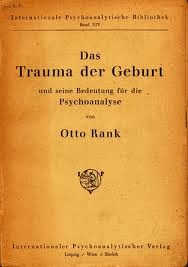The Trauma of Birth
 Cover of the first edition | |
| Author | Otto Rank |
|---|---|
| Original title | Das Trauma der Geburt |
| Language | German |
| Published |
|
| Publication place | Germany |
| Media type | Print (Hardcover and Paperback) |
| Pages | 224 (Dover edition) |
| ISBN | 0-486-27974-X (Dover edition) |
The Trauma of Birth (German: Das Trauma der Geburt) is a 1924 book by psychoanalyst Otto Rank, first published in English translation in 1929.[1] It is Rank's most popular book. Freud reacted critically to The Trauma of Birth, responding to Rank's ideas in his own work.
Summary
Rank argues that birth is an interruption of blissful uterine life from which people spend the rest of their lives trying to recover.[2] Rank believes that the birth trauma, and the fantasy of returning to the mother's womb, are far more important than subsequent traumas and fantasies.[3] Rank maintains that male homosexuality is based "on the abhorrence of the female genitals", which is in turn a result of the association between the female genitals and "the shock of birth."[4]
Reception
Sigmund Freud read the manuscript of The Trauma of Birth, and seems initially to have welcomed the book, even writing to Rank to tell him that he would accept its dedication to him. Freud's attitude to the book later changed, and he alternated between praising it and passing severe judgment on it. Several members of a committee secretly established in 1913 to protect Freud reacted more harshly. Both Karl Abraham and Ernest Jones expressed opposition to Rank's work, since they believed that it implicitly contradicted some of Freud's basic ideas.[5] Freud's work Inhibitions, Symptoms, and Anxiety (1926) was a response to The Trauma of Birth.[6]
Historian Peter Gay writes in Freud: A Life for Our Time (1988) that The Trauma of Birth is Rank's most popular book.[7] Author Richard Webster suggests in Why Freud Was Wrong (1995) that Abraham and Jones were correct in believing that The Trauma of Birth implicitly contradicts Freud's ideas.[5]
See also
References
Footnotes
- ^ Lieberman 1993. p. ix-xiv.
- ^ Janov 1978. p. 165.
- ^ Gay 1995. pp. 472-473.
- ^ Rank 1993. pp. 35-36.
- ^ a b Webster 2005. pp. 390-393.
- ^ Lieberman 2012. p. 255.
- ^ Gay 1995. p. 772.
Bibliography
- Books
- Gay, Peter (1995). Freud: A Life for Our Time. London: Papermac. ISBN 0-333-48638-2.
- Janov, Arthur (1978). The Anatomy of Mental Illness. London: Sphere Books.
- Lieberman, E. James; Kramer, Robert (2012). The Letters of Sigmund Freud & Otto Rank: Inside Psychoanalysis. Baltimore: The Johns Hopkins University Press. ISBN 978-1-4214-0354-0.
- Lieberman, E. James; Rank, Otto (1993). The Trauma of Birth. New York: Dover Publications. ISBN 0-486-27974-X.
- Rank, Otto; Lieberman, E. James (1993). The Trauma of Birth. New York: Dover Publications. ISBN 0-486-27974-X.
- Webster, Richard (2005). Why Freud Was Wrong: Sin, Science and Psychoanalysis. Oxford: The Orwell Press. ISBN 0-9515922-5-4.
